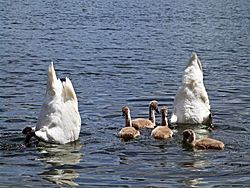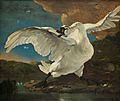Mute swan facts for kids
Quick facts for kids Mute swan |
|
|---|---|
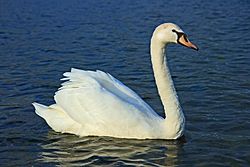 |
|
| Conservation status | |
| Scientific classification | |
| Kingdom: | |
| Phylum: | |
| Class: | |
| Order: | |
| Family: | |
| Subfamily: |
Anserinae
|
| Tribe: |
Cygnini
|
| Genus: | |
| Species: |
C. olor
|
| Binomial name | |
| Cygnus olor (Gmelin, 1789)
|
|
The mute swan (Cygnus olor) is a beautiful type of swan. It belongs to the same family as ducks and geese, called Anatidae. These swans are originally from many parts of Europe and Asia. Sometimes, they visit northern Africa in winter. Mute swans have also been brought to places like North America, Australasia, and southern Africa, where they now live in the wild.
Contents
What Does a Mute Swan Look Like?
Mute swans are very large birds, growing to be about 125 to 170 centimeters (49 to 67 inches) long. They have bright white feathers all over their bodies. Their bill is orange with a black border. You can easily spot a mute swan by the noticeable black knob on top of its bill.
When a mute swan swims, it holds its long neck in a graceful "S" shape, with its bill pointing downwards. This is different from other swans, like whooper swans, which usually hold their necks straight up. Male mute swans often arch their back wing feathers over their backs. This is a way they show off or look ready to defend themselves.
Mute Swan Behavior
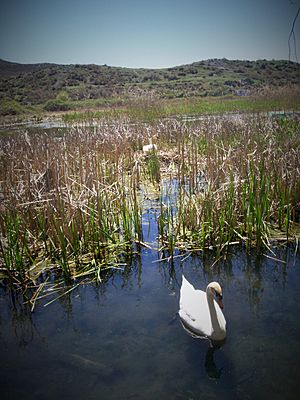
Mute swans build large nests using plants found near water. They usually place these nests in shallow water, on islands, or at the very edge of a lake. They are monogamous, meaning a pair stays together for life. They often use the same nest every year, fixing it up as needed. Both the male and female swans help take care of the nest. After their young, called cygnets, learn to fly, you can often see entire swan families searching for food together.
They eat many different kinds of plants. They use their long necks to reach plants underwater. They also graze on land, eating plants like oilseed rape and wheat. Sometimes, large groups of swans feeding in winter can damage farm crops. This happens both from eating the plants and from stepping on them with their big webbed feet.
Unlike black swans, mute swans usually like to have their own space. A single pair will often live on a smaller lake. However, in some places where there's a lot of food, they can live in large groups, called colonies. The biggest colonies can have over 100 pairs of swans. For example, there's a famous colony at Abbotsbury Swannery in England. Young swans, who are not yet paired up (usually 3-4 years old), often form bigger groups. These groups can have hundreds of birds and gather at special spots.
Mute swans are quieter than some other swans. They make sounds like grunting, hoarse whistling, and snorting. They often use these sounds to talk to their cygnets. If another animal or person gets too close to their territory, they will usually hiss. The most unique sound of a mute swan is the loud throbbing noise their wings make when they fly. You can hear this sound from far away, helping swans find each other in the air. Young cygnets are quite noisy. They make whistling and chirping sounds when they are happy, and harsh squawking noises if they are upset or lost.
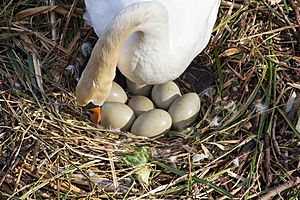
Mute swans can be very protective of their nests, mates, and young. When a mute swan feels threatened, it usually starts with a loud hiss. If that doesn't work, it might attack. Swans attack by hitting with their powerful wings and biting with their large bills. They might grab smaller birds, like ducks, and throw them away from their family. The male swan, called a cob, is in charge of protecting the cygnets in the water. He might even attack small boats if he thinks they are a danger to his young. He will also try to chase away animals like foxes that might be a threat.
The well-known pose where a swan curves its neck back and raises its wings is called "busking." This is a way for them to show they are ready to defend themselves. When they do this, they paddle both feet together, which makes them move in a jerky way. Swans can also use this "busking" posture to help them move across water with the wind, like windsurfing!
Reproduction and Life Cycle
Mute swans usually lay between four and ten eggs. The female swan sits on the eggs to keep them warm for about 36 days. The young cygnets cannot fly until they are 120 to 150 days old. This is important for swans living in colder northern areas. The cygnets must learn to fly before the water freezes over for winter.
Where Mute Swans Live
Mute swans naturally live in mild climate areas of Europe and western Asia. They can be found as far east as the Russian Maritimes.
In northern Europe and Asia, they sometimes migrate south for winter, reaching north Africa and the Mediterranean Sea. The UN Environment Programme lists mute swans in 70 countries. They breed in 49 of these countries and are seen as visitors in 16 others. While most mute swans in Japan today were brought there by people, old Japanese scrolls show wild mute swans from over a thousand years ago. Wild swans from mainland Asia still visit Japan rarely in winter.
Mute swans are protected in most places where they live. However, they are sometimes kept in parks and ponds outside their natural areas. Some of these captive swans have escaped and now live in the wild, for example, in the eastern United States and the Great Lakes region.
Mute Swan Populations Around the World
Native Populations
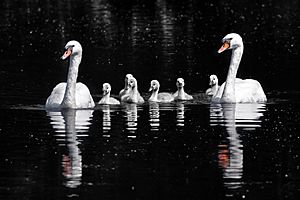
There are about 500,000 mute swans in their native areas after the breeding season. About 350,000 of these live in the areas that were once part of the former Soviet Union. The largest group of breeding swans, with 11,000 pairs, is found in the Volga Delta.
In the United Kingdom, there were about 22,000 mute swans in the winter of 2006–2007. This was a small decrease from the highest number of about 26,000–27,000 birds in 1990. About 5,300 of these were breeding pairs, and the rest were younger swans. Other large populations in Europe include Germany, Denmark, Poland, the Netherlands, Ireland, and Ukraine.
For many centuries, mute swans in Britain were raised for food. People would mark their feet or beaks to show who owned them. These marks were registered with the Crown, and a Royal Swanherd was in charge. Any unmarked swans belonged to the Crown, which is why the swan became known as the "Royal Bird." It's possible that raising swans like this helped save them from being hunted too much in Britain.
In western Europe, many mute swans were hunted between the 13th and 19th centuries. Only semi-domesticated birds kept by wealthy landowners survived. Better protection in the late 1800s and early 1900s allowed the swans to return to most of their old homes. Later, from about 1960 to the early 1980s, their numbers dropped again in parts of England. This was mainly because swans were swallowing discarded fishing sinkers made of lead. After lead weights were replaced with safer options, mute swan numbers quickly grew again.
Introduced Populations
Mute swans were brought to North America in the late 1800s. Their numbers have grown so much there that they are now seen as an invasive species. This means they can sometimes harm other waterfowl and local ecosystems. For example, in the lower Great Lakes, the number of mute swans increased by at least 10% each year between 1971 and 2000. This meant their population doubled every seven to eight years. Studies have shown that where mute swans live, they can greatly reduce the amount of underwater plants.
Other places where mute swans have been introduced have smaller populations. There are about 200 in Japan, fewer than 200 in New Zealand and Australia, and about 120 in South Africa.
In New Zealand, mute swans used to have full protection under the Wildlife Act of 1953. However, in 2010, this protection was lowered. They are still protected, but the Minister of Conservation can now allow them to be killed or kept in captivity.
A small group of wild mute swans lives near Perth, Australia, but their number is believed to be less than 100.
Mute Swans in Popular Culture
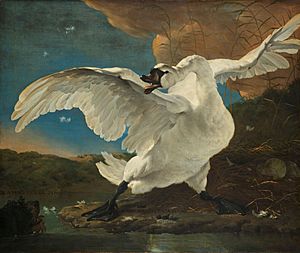
- A mute swan was featured on a special Irish Euro coin in 2004. This coin celebrated the 10 new countries joining the European Union.
- The mute swan has been the national bird of Denmark since 1984. Before that, the skylark held this title.
- The famous fairy tale "The Ugly Duckling" by Hans Christian Andersen tells the story of a young swan who was teased for being different. He later grows into a beautiful swan, surprising everyone.
- In the well-known ballet Swan Lake, the main character, Princess Odette, and her friends are turned into swans by a bad spell.
- Today, the British Monarch still has the right to own all unmarked mute swans in open waters. However, Queen Elizabeth II only used this right on certain parts of the River Thames and its nearby waterways. This ownership is shared with two old London companies, the Vintners' and Dyers' Companies, who were given these rights by the Crown in the 1400s.
- For centuries, mute swans in the moat at the Bishops Palace in Wells, England, have been trained to ring bells. They do this by pulling strings to ask for food. Two swans there can still ring for lunch today!
- The pair of swans in the Boston Public Garden are named Romeo and Juliet, after the famous Shakespearean couple. However, it was later discovered that both swans are actually female!
Gallery
-
Four mute swans along the bank of the Etobicoke Creek.
Images for kids
-
Two mute swan cygnets a few weeks old. The cygnet on the right is a "Polish swan" color, which carries a gene for leucism.
-
The Threatened Swan (around 1650) by Jan Asselijn.
-
Mute swans on Lake Orongoi, Buryatia.
-
Mute swans on a field by the Vistula River in southern Poland.
-
A mute swan and cygnets on a duckweed-covered pond in New York City.
See also
 In Spanish: Cisne vulgar para niños
In Spanish: Cisne vulgar para niños



